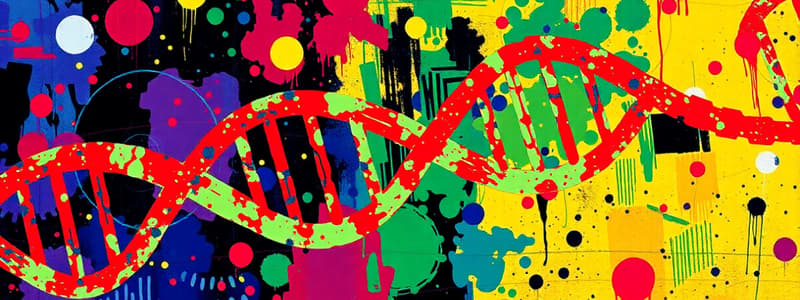Podcast
Questions and Answers
What is NOT true about the process of agarose gel electrophoresis?
What is NOT true about the process of agarose gel electrophoresis?
- The process can visualize RNA fragments. (correct)
- It allows DNA fragments to move towards the positive electrode.
- Larger DNA fragments move more slowly through the gel.
- It involves the use of restriction enzymes to cut DNA.
Which statement about restriction enzymes is incorrect?
Which statement about restriction enzymes is incorrect?
- They create fragments of various lengths for analysis.
- Different enzymes recognize different DNA sequences.
- All restriction enzymes cut DNA at the same sequence. (correct)
- They can be used to cut DNA at specific sequences.
In the context of gel electrophoresis, what does the term 'ladder' refer to?
In the context of gel electrophoresis, what does the term 'ladder' refer to?
- A type of gel medium used for electrophoresis.
- An equipment setup that helps to stabilize the gel.
- A tool used to measure DNA concentration.
- A mix of DNA fragments of known sizes used for comparison. (correct)
What is the role of the UV transilluminator in gel electrophoresis?
What is the role of the UV transilluminator in gel electrophoresis?
Why is it important to cover the electrophoresis chamber with a lid during the process?
Why is it important to cover the electrophoresis chamber with a lid during the process?
What is the primary purpose of using a loading dye during agarose gel electrophoresis?
What is the primary purpose of using a loading dye during agarose gel electrophoresis?
Which component is essential for the staining and visualization of DNA in agarose gel electrophoresis?
Which component is essential for the staining and visualization of DNA in agarose gel electrophoresis?
At what temperature should the DNA samples be incubated after adding the enzyme mix?
At what temperature should the DNA samples be incubated after adding the enzyme mix?
What is the role of agarose in the electrophoresis process?
What is the role of agarose in the electrophoresis process?
What step must be performed after melting the agarose to prepare the gel?
What step must be performed after melting the agarose to prepare the gel?
Which of the following accurately describes the migration direction of DNA in agarose gel electrophoresis?
Which of the following accurately describes the migration direction of DNA in agarose gel electrophoresis?
What is the correct concentration of agarose in the gel preparation described?
What is the correct concentration of agarose in the gel preparation described?
Which action should NOT be performed when mixing the DNA samples with the enzyme mix?
Which action should NOT be performed when mixing the DNA samples with the enzyme mix?
What is the primary purpose of DNA fingerprinting in the context of a criminal investigation?
What is the primary purpose of DNA fingerprinting in the context of a criminal investigation?
Which of the following accurately describes Restriction Fragment Length Polymorphism (RFLP)?
Which of the following accurately describes Restriction Fragment Length Polymorphism (RFLP)?
During the DNA analysis process, which step directly follows the restriction digest of the DNA samples?
During the DNA analysis process, which step directly follows the restriction digest of the DNA samples?
Which statement is true regarding the preparation of the agarose gel for electrophoresis?
Which statement is true regarding the preparation of the agarose gel for electrophoresis?
What type of biological evidence was collected from the crime scene to aid in the investigation?
What type of biological evidence was collected from the crime scene to aid in the investigation?
In the context of the investigation, which group of individuals are considered suspects?
In the context of the investigation, which group of individuals are considered suspects?
What is the expected outcome after performing a comparison of the DNA fragments from the suspects and the victim?
What is the expected outcome after performing a comparison of the DNA fragments from the suspects and the victim?
What is a crucial feature of the genomic site involved in RFLP analysis?
What is a crucial feature of the genomic site involved in RFLP analysis?
Flashcards
Agarose Gel Electrophoresis
Agarose Gel Electrophoresis
A technique used to separate nucleic acids, primarily DNA, based on their size.
Agarose
Agarose
A polysaccharide derived from seaweed, forming the matrix of the gel.
Electrophoresis
Electrophoresis
The movement of charged molecules through a gel under the influence of an electric field.
RedGel
RedGel
Signup and view all the flashcards
Loading Dye
Loading Dye
Signup and view all the flashcards
Restriction Digest
Restriction Digest
Signup and view all the flashcards
Tris-Acetic acid-EDTA buffer (TAE)
Tris-Acetic acid-EDTA buffer (TAE)
Signup and view all the flashcards
Agarose Gel Preparation
Agarose Gel Preparation
Signup and view all the flashcards
DNA Fingerprinting
DNA Fingerprinting
Signup and view all the flashcards
Restriction Fragment Length Polymorphism (RFLP)
Restriction Fragment Length Polymorphism (RFLP)
Signup and view all the flashcards
Restriction Enzymes
Restriction Enzymes
Signup and view all the flashcards
Polymerase Chain Reaction (PCR)
Polymerase Chain Reaction (PCR)
Signup and view all the flashcards
Restriction Site
Restriction Site
Signup and view all the flashcards
DNA Fingerprint
DNA Fingerprint
Signup and view all the flashcards
What are restriction enzymes?
What are restriction enzymes?
Signup and view all the flashcards
How does Agarose Gel Electrophoresis work?
How does Agarose Gel Electrophoresis work?
Signup and view all the flashcards
What is the purpose of Agarose Gel Electrophoresis?
What is the purpose of Agarose Gel Electrophoresis?
Signup and view all the flashcards
Why does DNA move toward the positive electrode in Agarose Gel Electrophoresis?
Why does DNA move toward the positive electrode in Agarose Gel Electrophoresis?
Signup and view all the flashcards
How are DNA strands held together?
How are DNA strands held together?
Signup and view all the flashcards
Study Notes
Forensic DNA Fingerprinting
-
Theoretical Background:
- Introduction to DNA fingerprinting
- Restriction digest of DNA samples
- Principle of agarose gel electrophoresis
-
Methodology and Protocol:
- Sample and agarose gel preparation
- Electrophoresis of DNA samples
- Analysis and interpretation of results
The Crime
- A medical student from European University Cyprus was found dead at the university parking lot.
- The student was murdered.
- The CSI Nicosia Department asked fellow medical students for assistance in finding the murderer.
The Clues
- Evidence suggests a violent struggle at the crime scene.
- DNA was collected from under the victim's fingernails.
The Suspects
- There are five suspects: the heartbroken ex-girlfriend, the jealous brother, the girlfriend, the campus security guard, and the father of the heartbroken ex-girlfriend.
The Plan
- The students worked together to solve the crime.
- They reviewed the procedures they learned and determined a solution.
- DNA from the suspects was isolated and compared to the DNA from the crime scene using the RFLP technique.
- DNA fingerprinting connects biological evidence to suspects in criminal investigations.
Restriction Fragment Length Polymorphism (RFLP)
- A type of polymorphism caused by variations in DNA sequences recognized by restriction enzymes.
- Short genomic sites (4-8 nucleotides) that differ among individuals are polymorphic.
- DNA is treated with restriction enzymes that cut the DNA into fragments of various lengths.
- Resulting fragments are separated by length, creating a unique pattern for each individual.
Experimental Procedure (Part A: Restriction Digest)
- 10 µl of DNA sample from each suspect and crime scene are transferred to labelled tubes.
- 10 µl of enzyme mix was added to each respective tube.
- The tubes are mixed (flicking gently).
- Tubes are placed in a 37°C water bath for 45 minutes
Experimental Procedure (Part B: Agarose Gel Electrophoresis and Visualization of DNA Fragments)
- A 1% agarose gel is prepared using 100 ml of TAE buffer and 1 g of agarose in an Erlenmeyer flask.
- The agarose is melted in a microwave or on a heat source, and periodically swirled to avoid boiling.
- The gel is poured into a casting tray and allowed to solidify.
- The comb is removed and the gel is placed in an electrophoresis chamber filled with buffer solution.
- 20 µl of dye sample is loaded into each well.
- Electrophoresis is performed for 40 minutes at 100-120V.
- The gel is visualized using a UV transilluminator, and the results are documented and interpreted by the students and instructor.
Experimental Procedure - DNA Samples should contain:
- The following DNA samples and volumes are used
- Crime Scene (CS) - 10 µl
- Suspect 1 (S1) - 10 µl
- Suspect 2 (S2) - 10 µl
- Suspect 3 (S3) - 10 µl
- Suspect 4 (S4) - 10 µl
- Suspect 5 (S5) - 10 µl
- For each sample - 20 µl of Eco/Pst enzyme mix.
RFLP Markers Inheritance & Test Validity
- Diagram showing inheritance patterns of RFLP markers and potential genotypes (AA, aa, Aa) among family members (parents and siblings)
Agarose Gel Electrophoresis Principle
- Agarose Gel electrophoresis is used to separate nucleic acids by size.
- Nucleic acids migrate through an agarose gel due to an electric field (cathode- to anode+).
- Agarose is a polysaccharide extracted from seaweed.
- DNA is visualized using dyes like GelRed, which bind to DNA and fluoresce under UV light.
- A tracking dye is mixed with the sample to monitor its movement.
Questions:
- Which of the following is FALSE? – Option D
- What is the purpose of Agarose Gel Electrophoresis? – Option (C)
Studying That Suits You
Use AI to generate personalized quizzes and flashcards to suit your learning preferences.




